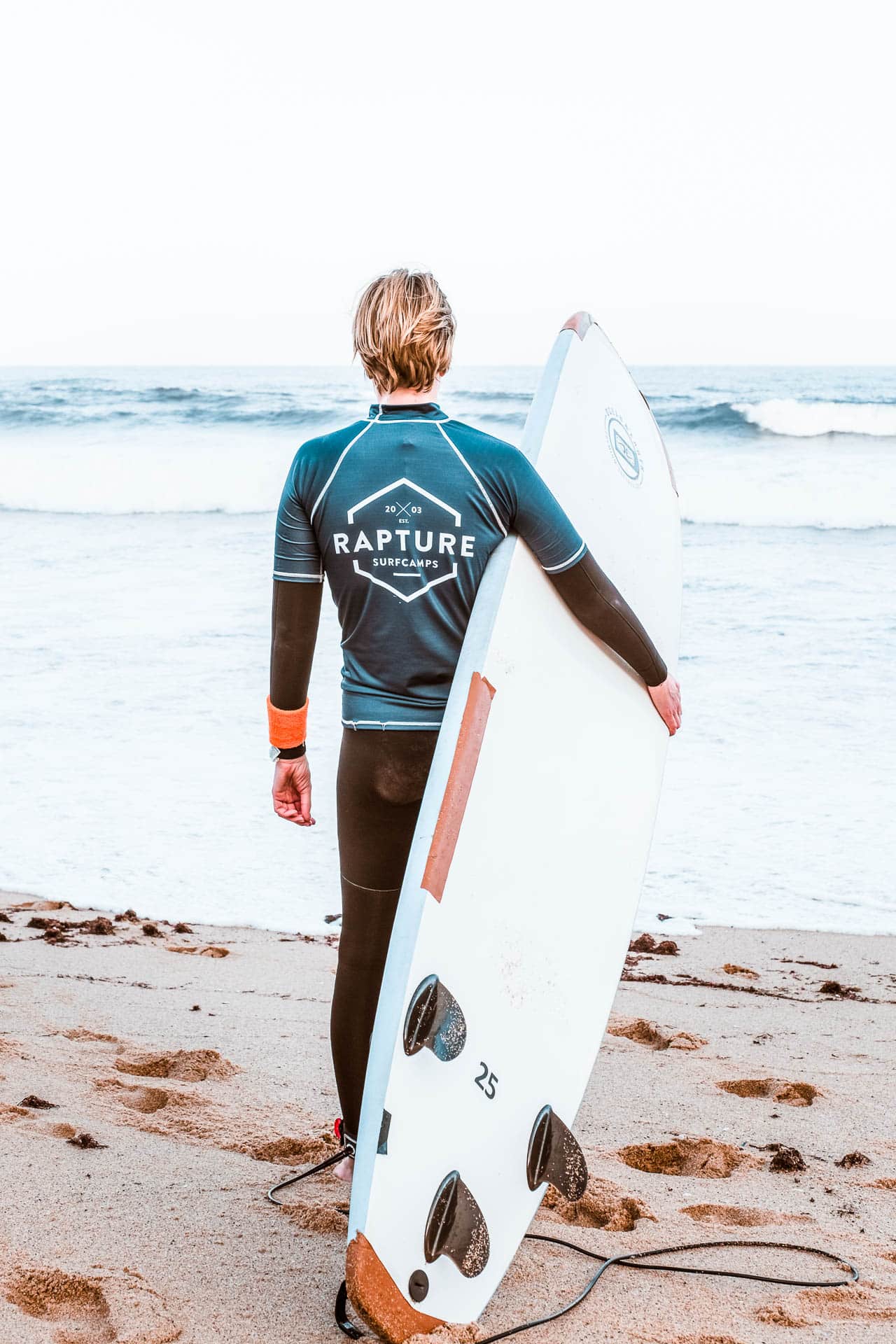Surfing, with its thrill of riding waves and the vast expanse of the open ocean, is undoubtedly exhilarating. From the pristine beaches to the adrenaline-inducing waves, surfing offers a unique blend of excitement and tranquillity.
However, as with any water sport, safety should be a paramount concern. Whether you’re a beginner eagerly embracing your first surfing lesson or an experienced surfer seeking new challenges, understanding and practicing surf safety is crucial for a rewarding and secure surfing experience.
In this guide, we’ll delve into the essential surf safety tips and aspects that every aspiring surfer must grasp before catching those breath taking waves.
1. Surf Etiquette While You Share the Waves
One of the cornerstones of safe surfing is adhering to proper surf etiquette. The ocean is a shared playground, and respecting other surfers’ space and waves is vital for a harmonious surf session.
As you venture into different surf spots, remember that each break may have its unwritten rules about wave priority, line-up positioning, and wave sharing. Being courteous to fellow surfers helps avoid collisions and maintains a positive atmosphere in the line-up, contributing to everyone’s safety and enjoyment.
2. Be realistic when you evaluate your skills
While the allure of big waves and daring maneuvers may be appealing, it’s crucial to know your limits as a surfer. Pushing yourself beyond your current skill level can lead to dangerous situations and accidents.
Always prioritize safety over ego, and gradually progress your skills under the guidance of a qualified surf instructor. This approach not only reduces the risk of injury but also enhances your overall surfing experience. Remember, the ocean is a dynamic environment that requires respect and caution.
3. Respect the ocean
Developing a basic understanding of ocean dynamics is fundamental for safe surfing. Learn about the behavior of waves, how they break, and the direction of currents.
A solid understanding of wave patterns and rips can help you make informed decisions when choosing where and when to paddle out. It’s also essential to be aware of oncoming waves to avoid collisions and maintain a safe distance from fellow surfers.
4. Maintain a proper paddling technique
Paddling is a fundamental skill in surfing, and doing it correctly contributes to both your efficiency in the water and your safety. Maintain a proper paddling technique that engages your core muscles and minimizes strain on your shoulders.
A strong and efficient paddle allows you to catch waves more effectively and navigate through challenging conditions. Additionally, practicing proper paddling techniques reduces the risk of overexertion and potential injuries.
5. Understanding rip currents
Rip currents are powerful currents that can carry even the most experienced surfers away from the shore. It’s essential to know how to identify rip currents and how to escape them safely.
Similarly, understanding how oncoming waves can impact your movements is crucial for maintaining control and avoiding wipe-outs.
6. Board and body awareness
Your surfboard is your trusty companion in the water, but it can also pose risks if not handled properly. Always be conscious of the position of your board and keep it under control to avoid collisions with other surfers.
When paddling out or catching waves, maintain awareness of your surroundings and ensure that you’re not putting yourself or others in danger.
7. Learn from experienced surfers
One of the best ways to enhance your surfing safety is to seek guidance from experienced surfers.
Experienced surfers can teach you about proper paddling techniques, wave selection, and how to read the ocean effectively. Their insights can prove invaluable as you strive to improve your surfing skills while minimizing risk.
8. Understand the different types of hazards around you
Different surf spots present unique challenges and hazards. Some beaches may have breaking waves that crash close to the shore, while others may feature powerful rip currents.
Before paddling out, take a moment to observe the conditions, identify potential hazards, and make informed decisions about where to surf. Being aware of the specific challenges posed by each surf spot contributes to your overall safety and helps you make wise choices in the water.
9. Choose suitable surf spots
Selecting the right surf spot is key to ensuring your safety while learning to surf. As a beginner, opt for beginner-friendly spots with small, consistent waves, sandy bottoms, and manageable conditions. Avoid reef breaks or waves that are too large for your skill level.
10. Take Care of Your Body
- Stay Hydrated: Surfing can be physically demanding, and staying hydrated is crucial for maintaining focus and energy. Carry water with you and drink regularly to prevent dehydration.
- Practice Good Warm-Up: Warming up your muscles before hitting the waves helps prevent injuries. Engage in light stretching and movement to prepare your body for the physical demands of surfing.
- Sun Protection: Spending extended periods in the sun while surfing exposes your skin to harmful UV radiation, increasing the risk of sunburn and long-term damage, such as skin cancer. Prioritize sun protection by wearing broad-spectrum sunscreen with a high SPF, a rash guard, and a wide-brimmed hat. Additionally, consider wearing surf-specific sun protection gear designed to stay in place even during rigorous movements. Protecting your skin not only ensures your immediate comfort but also safeguards your long-term health.
Some More Safety Tips
- Wear a Leash: Always attach your surfboard to a leash around your ankle. This prevents your board from drifting away in case you fall, keeping you connected and safe.
- Practice Proper Fall Techniques: Learn to fall safely to avoid collisions and injuries. Falling away from your board and protecting your head are essential skills to master.
- Protect your Head: Accidents can happen even to the most experienced surfers. In case you find yourself in a challenging situation where a collision or wipeout is imminent, prioritize protecting your head. Cover your head with your arms to minimize the risk of injury. While it’s important to maintain a relaxed posture while paddling and catching waves, your immediate safety should be your primary concern.
Listen to Lifeguards: If surfing at a beach with lifeguards, follow their instructions and heed their advice. They have valuable insights into current conditions and safety hazards. - Stay Away from Wildlife: While encounters with marine life are rare, it’s best to avoid disturbing or provoking animals. Give them space and respect their environment.
- Learn Basic First Aid: Having basic first aid knowledge can be invaluable in case of minor injuries or accidents while surfing. Carry a small first aid kit with essentials.
- Avoid Surfing Alone: Surfing alone increases the risks in case of accidents or emergencies. Whenever possible, surf with others to have assistance and support.
- Plan Your Exit: Before paddling out, identify a safe exit point. Knowing where to paddle back to shore can prevent confusion and unnecessary risks.
Remember, learning to surf is a journey, and it’s okay to take your time. Embrace the process, learn from experienced surfers, and gradually build your skills. The more you prioritize surf safety and continuously improve your techniques, the more fun and fulfilling your surfing experience will become.
From seasoned wave riders to beginners with a taste for adventure, the responsibility of surfing safely rests on everyone’s shoulders. Surfing isn’t just about mastering the technicalities—it’s about cultivating an ethos that revolves around looking out for one another and contributing positively to the surf community.
Surfing requires not only mastering the art of riding waves but also the art of staying safe. From the exhilaration of the first movement, as you paddle out to the joy of catching a perfect wave, every moment is an opportunity to exercise caution and responsibility.
Whether you’re a surfer closest to the shore or riding the outermost waves, the respect you show to fellow surfers and your surroundings exemplifies your commitment to a safe and enjoyable surfing environment.
By combining skill, knowledge, and respect, you’ll not only safeguard yourself but also embrace the joy that surfing brings. So, whether you’re paddling out to catch good waves or simply enjoying the presence of the sea, carry with you the wisdom of safe surfing. Let it be the current that guides you through the intricate waters of this incredible journey, ensuring that every surf is not just a thrilling adventure but also a secure one.
Reviews From Our Guests
FAQs
Surfing safety is crucial to prevent accidents, injuries, and ensure an enjoyable experience in the water. Following safety guidelines helps protect both yourself and other surfers.
Before entering the water, check surf conditions, weather forecasts, and tide information. Ensure you are physically prepared, warmed up, and familiar with the beach’s specific hazards.
Yes, wear a well-fitted leash to keep your board attached to you. Wearing a surfboard leash helps prevent your board from becoming a hazard to yourself and others in the water.
Look for wave size, rip currents, and water depth. Be cautious of any hazardous underwater obstacles. Understanding the conditions helps you make informed decisions about whether it’s safe to surf.
If caught in a rip current, remain calm, and don’t panic. Swim parallel to the shore to escape the current, rather than trying to swim directly back to the beach.
Pay attention to your surroundings, communicate clearly, and be aware of other surfers in the lineup. Look both ways before paddling for a wave and be mindful of your board’s position.
If you start feeling fatigued, it’s essential to paddle to shore and take a break. Fatigue can lead to diminished focus and increased risk of accidents, so rest when needed to ensure your safety in the water.


